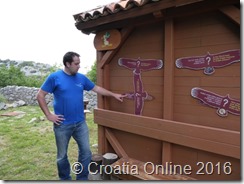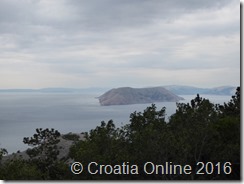
This morning I read a very interesting article in Croatia Week entitled “Top Thermal Spas Worth Visiting in Croatia”. It reminded me of an era not so long ago when “Wellness” in Croatia was more traditional – the smell of sulphur and chlorine, massive and overheated communist-era hotels in need of maintenance, and not all that much to feel “well” about!
In 2008, however, the modern concept of Wellness was being well and truly adopted in Croatia and I wrote a feature for Time Out Croatia to help reflect and illustrate this new trend. I’ve reproduced the full text submitted below, with updated websites where necessary, as many of these then “newer” wellness facilities are still at the forefront of the industry. Recently, of course, most new four of five star hotel of any size (and often the new three stars as well) include some sort of wellness facility, and there are 86 entries in the separate Wellness section of the Croatia Tourist Board website so, on the whole, it’s no longer something to write home about. Increasingly however, health tourism in Croatia is getting more attention, with some of the latest technology now available in modern dental practices hoping to attract more international health tourists.
For the full Croatia Week article, link to:
Croatia Week - Top Thermal Spas In Croatia Worth Visiting
For the Health and Wellness Section of the Croatian Tourist Board website, go to Croatia HR - Health and Wellness
***
Time Out Croatia On Wellness - 2008
Wellness, an intrinsic part of Croatia’s culture and history was, until relatively recently, only modestly exploited. Roman Emperor Diocletian may well have chosen Split as the best location for his magnificent palace in the 3rd Century AD, partly on health grounds. The Romans knew about the healing powers of sulphur, the Emperor suffered from arthritis, and the palace was built around two sulphur springs that, according to archaeologists, formed part of a medical complex within the palace walls.
Sulphur springs, healing mud, a great climate, skilled and educated professionals, attractive prices and an abundance of other natural resources all mean that Croatia has long had the potential to be a Wellness haven. Now, with substantial investment, it’s capitalising on its natural assets to cater to this ever growing and discerning market. Most new or newly refurbished hotels of any size are now including a Wellness Centre as standard, medical tourism is on the up and Croatia even has a Wellness Island, and a dialysis centre specially catering for foreign tourists with kidney problems.
One of Croatia’s newest mainstream Wellness Centres is Hotel Horizont - Hotel Horizont Wellness - in the Makarska Riviera resort of Baška Voda, flagship hotel of the Russian owned Hoteli Baška Voda Group. Here you’ll get a sublime combination of Russian opulence, contemporary design, modern facilities and a huge choice of treatments. The Wellness, Spa and Fitness area covers 2,000 square meters and is skilfully designed to provide an intimate Aladdin’s cave of treats. The Russian masseur has a reputation for being able to diagnose and treat several complaints just by touch and, to stay with the Russian theme, you can lunch in the Russian restaurant nearby. The vast choice of pools and saunas includes an infrared sauna, increasingly popular with western visitors for apparently achieving a multitude of benefits including cholesterol and blood pressure control, weight loss, treatment of skin problems and pain relief. If infrared’s your thing the Wellness Centres in Hotel Uvala and Hotel President in Dubrovnik, Hotel Corinthia-Baška on Krk Island, Blusun Hotel Elephusa in Bol on Brač Island, and Bluesun Hotel Soline, Brela will also oblige.
Prior to the arrival of Hotel Horizont, Falkensteiner’s Club Funimation Acquapura Thalasso & Spa Center in Borik -Falkensteiner Wellness - was the clear leader of the Dalmatian pack, with 2,000 plus square metres of modern facilities including 310 square meters of heated indoor and outdoor pools, a large fitness area and a range of Thalasso treatments (seawater and seaweed packs). The ultimate in private luxury is Funimation’s Presidential Suite which has its very own massage room, a small freshwater pool on the terrace, and a spa area with steam bath, sauna and whirlpool.
These and other upmarket mainstream Wellness Centres offer a mind boggling array of facilities and treatment. Sunčani Hvar’s Adriana Hotel in Hvar - Adriana, Hvar, Spa Hotel - focuses on a holistic “Sensori” approach to help guests make the most of its 1,400 square metres of facilities, including a rooftop seawater swimming pool; the Grand Hotel Adriatic in Opatija - Hotel Adriatic has its 600 square metres of facilities on the top floor to provide a panoramic view of the Kvarner bay as you relax; Remisen’s Premium Hotel Ambassador - Hotel Ambassador Opatija - also in Opatija, embraces Chinese philosophy to provide its Five Elements concept in a Wellness Centre covering two floors and 1,300 square metres; Aurora - Wellness Hotel Aurora - in Mali Losinj, is scheduled to open its new Wellness Centre at the end of May this year and Le Méridien’s Grand Hotel Lav - Le Meridien Lav, Split - near Split, brings a contemporary perspective to our opening story in its Diocletian spa and Aroma Grotto [in 2016 it’s claiming to be the largest spa in Croatia!].

And if a few hundred square metres of Wellness facilities isn’t enough for you then how about a whole island? Hotel Istra – Maistra; Istria - lies on Otok Sv Andrije, nicknamed Wellness Island, a fifteen minute boat ride from Rovinj.
Less mainstream, and often less modern, facilities have grown up around natural thermal springs dotted all over Croatia. Take into account their gradual evolution (often from Roman Times!) when assessing them against more recently built facilities - some have a distinctively Eastern European feel. The Tuhelj Thermal Spa Terme Tuhelj - in the Zagorje region of Croatia, 40 kilometres (25 miles) from Zagreb, claims to be the largest Wellness Centre in Croatia and to have one of the best healing muds in Europe. It’s built around thermal springs, at the bottom of which lies the mud. Elements of silicon, aluminium, iron, magnesium, potassium, sodium oxides, sulphur and organic compounds are believed to relieve anything from gout to cellulite. The thermal springs have a similarly impressive list of components and healing properties, and the water is warm enough to swim in all year round. The area has spawned a Water Park, as well as a number of sporting activities, which will keep the kids amused whilst mum and dad wallow in the mud. A similar range of facilities has grown up around the Bizovac thermal springs in Slavonia, the inland Istrian springs between Buzet and Motuvun, and a whole host of others. Perhaps the most modern and extensive of these facilities is in the most northernmost part of Croatia, close to the Slovenian, Hungarian and Austrian borders. The Thermal Spa St Martin -Terme Sv Martin - Spa - describes itself as a Wellness Oasis and offers apartment accommodation in a complex that includes Wellness and Beauty Centres, 18,000 square feet of indoor and outdoor water area, bars, restaurants and a pub.

A natural offshoot of Wellness is specialised health tourism. Dental tourism was an early seedling and now appears to be growing fast. In general, Croatian dental surgeries have well trained and qualified dentists and nurses, the latest in specialised equipment, and compete very favourably on price compared with other parts of Europe. And what better way to get over dental chair nerves than combining a new set of choppers with a relaxing holiday in a comfortable hotel by the Adriatic. Treatment Abroad (www.treatmentabroad.net) is just one of the websites that Croatian dentists are using to promote their services. According to client testimonials a new set of teeth can cost less than half the price of the UK equivalent. Dentex- Dentex Dental - has three studios in Zadar and, in partnership with nearby Falkensteiner Hotels (see above), offers a tailor made package of dental treatment combined with a holiday.
Directory
Adriana Hotel - http://www.suncanihvar.com/adriana-hvar-spa-hotel.html - offers one of the best Wellness facilities on Hvar Island.
Hotel Ambassador - http://www.remisens.com/en/hotel-ambasador - in Opatija uses Chinese philosophy and the “Five Elements Concepts” to provide a holistic programme in its 1,300 square metre wellness area.
Hotel Aurora - http://www.losinj-hotels.com/en/accommodation/hotel-aurora - on fast developing Mali Lošinj Island is undergoing a major face lift and due for its grand re-opening in early summer to include a state of the art Wellness Centre.
Wellness Baška - http://www.krk.hr/en/offer/wellness/baska - designed to give the feel of a Mediterranean Street, is part of the Hotel Baška complex on Krk Island. Be aware though that there’s still some building going on to complete an apartment block on the complex which is scheduled for completion in May 2008.
Bizovac Thermal Springs www.bizovacke-toplice.hr. In Slavonia, this complex, built around thermal spas, discovered whilst searching for oil, includes two hotels, an aqua park, a range of sports facilities and a clinic.
Blusun Hotels - https://www.bluesunhotels.com/en/wellness-package-deals-2016.aspx - have a wide range of Wellness packages available from their hotels Elaphusa in Bol on Brač Island, Alan in Starigrad Paklenica, Kaj in Marija Bistrica and Soline in Brela, near Makarsaka.
Dentex - https://www.medtrip.com/clinic/dentex-dental-clinic - have three studios in Zadar and, in partnership with Falkensteiner Hotels in nearby Borik, offer a full range of dental treatment and holiday packages.
Club Funimation - https://www.falkensteiner.com/en/hotel/borik - has one of the largest Wellness facilities in Dalmatia and an outdoor area with pool and slides that’s great for amusing the children.
Grand Hotel Adriatic - http://www.hotel-adriatic.hr/en/- in Opatija, offers the full range of treatments and a spectacular view from its top floor terraced Wellness Centre.
Hotel Horizont - http://www.hoteli-baskavoda.hr/en/8/wellness - in Baška Voda, near Makarska is open all year round and has one of the biggest and up to date Wellness Centres in Croatia.
Hotel Istra - http://www.maistra.com/ - lies on a small island near Rovinj and has a large Wellness area that extends outdoors into a Mediterranean Garden.
Le Méridien Grand Hotel Lav -http://www.lemeridienlavsplit.com/spa - features a Diocletian spa and aroma grotto amongst its brand new five star facilities in Podstrana, just outside Split.
Treatment Abroad (www.treatmentabroad.net) are a good site to keep up with medical tourism in Croatia. At the time of writing, dental treatment, from a number of providers, was the only option available but who knows what will be next.
Thermal Spa St Martin - http://www.spa-sport.hr/en/spa-wellness - is the centrepiece of a village dedicated to sustainable tourism. As well as the spa complex, the village has a deer farm, puts on a number of exhibitions of traditional trades and crafts, and provides for a wide range of sporting activities.
TopTerme Topusko - www.ljeciliste-topusko.com - 65 kilometres (41 miles) south of Zagreb, offers Wellness, medical, sports, and special programs centred on the healing waters of the local thermal springs and in the style of accommodation that will take you back to the Yugoslavian era – be warned!
Tuhelj Thermal Spa - http://www.terme-tuhelj.hr/gb - 40 kilometres inland from Zagreb, has a water park with indoor and outdoor pools, and a Wellness Centre focusing on the natural healing mud, thermal spas and Fango therapy.
Selce Thermal Spa - http://terme-selce.hr/en/ - near Crikvenica is a traditional spa of the more spartan variety and includes a clinical psychologist, physiotherapist and cardiologist in its team to offer anything from sports injury rehabilitation programs to those for senior citizens. Accommodation is either in their own apartments or in nearby hotels and private accommodation.
Hotel Uvala - http://www.dubrovnikhotels.travel/ - in Dubrovnik, has an infrared sauna amongst the many high tech facilities in its Wellness area.
Valamar Hotels - http://www.valamar.com/ - have a number of Wellness packages available from their four star hotels Diamant, in Poreč, and President in Dubrovnik






















